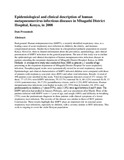| dc.identifier.citation | Nzunza R, Wurapa E, Kariuki N, Chek J, Ongus J, Bulimo W. "Epidemiological and clinical description of human metapneumovirus infectious diseases in Mbagathi District Hospital, Kenya, in 2008.". In: Options for the Control of Influenza VIII. Cape Town, South Africa; 2013:. | en |
| dc.description.abstract | Background: Human metapneumovirus (hMPV), a recently identified respiratory virus, is a leading cause of acute respiratory tract infection in children, the elderly, and immune-compromised persons. Studies have been done in a hospitalized pediatric population in coastal Kenya. However, there is limited information about the prevalence, epidemiology, and clinical presentation of hMPV infections in the general population. The aim of this study was to outline the epidemiologic and clinical description of human metapneumovirus infectious disease in patients attending the outpatient department of Mbagathi District Hospital, Kenya, in 2008. Methods: A retrospective study was conducted from 2008 in patients ≥ 2 months of age presenting at the outpatient department of Mbagathi District Hospital for acute respiratory infection. Nasopharyngeal swabs were systematically tested for several respiratory viruses. Epidemiologic and clinical characteristics of hMPV-infected children were compared with those of patients with respiratory syncytial virus (RSV) and other viral infections. Results: A total of 498 patients were enrolled in this study. Viral investigations detected a total of 271 viruses. Of these, 77 (15.5%) were hMPV infections, 78 (15.7%) seasonal flu A, 60 (12%) seasonal flu B, 13 (2.6%) panenterovirus, 36 (7.2%) parainfluenza viruses, and 6 (1.2%) RSV infections. Human metapneumovirus infections were higher in males (43, 55%) than in females (34, 45%), and predominantly in children ≤ 5 years (97%), only 2 (3%) were aged between 6 and 9 years. The hMPV infection had peaked in January-February, and was uncommon after March. Most of the patients infected with hMPV were < 1 year of age, and cough (100%) and difficulty in breathing (75%) were the predominant diagnosis in these patients with clinical symptoms of a lower respiratory tract infection. The severity of the disease was similar to those of RSV patients. Conclusions: These results highlight that hMPV plays an important role in seasonal acute respiratory tract infections, especially in children, with a severity similar to RSV infections. This work is ongoing to cover the wider Kenyan population | en |

